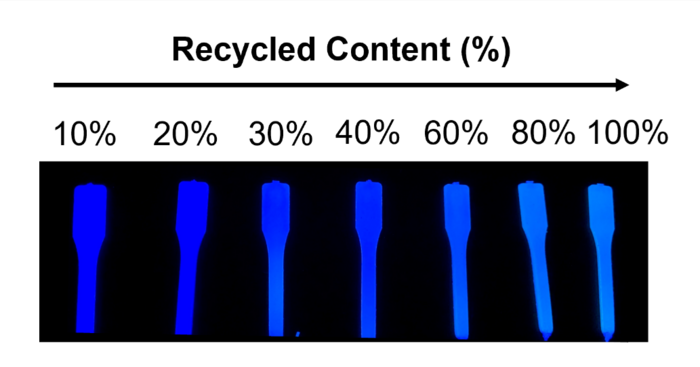To encourage more recycling, the U.K. taxes single-use plastic products containing less than 30% recycled material. But aside from a manufacturer’s word, there isn’t an easy way to verify this composition. Now, researchers reporting in ACS Sustainable Chemistry & Engineering have developed a simple, fraud-resistant technique to evaluate the recycled content of new plastic products. They added a fluorescent tag to plastic resins, successfully tracking their amount in products made with various polymers and colors.

Credit: Adapted from ACS Sustainable Chemistry & Engineering 2022
To encourage more recycling, the U.K. taxes single-use plastic products containing less than 30% recycled material. But aside from a manufacturer’s word, there isn’t an easy way to verify this composition. Now, researchers reporting in ACS Sustainable Chemistry & Engineering have developed a simple, fraud-resistant technique to evaluate the recycled content of new plastic products. They added a fluorescent tag to plastic resins, successfully tracking their amount in products made with various polymers and colors.
After reducing and reusing, recycling is the last line of defense for keeping plastic out of landfills or the environment. And now, some countries are putting financial pressure on manufacturers so they get with the program. Whereas the U.K. is taxing plastic products with little recycled content, other countries, such as Italy and Spain, plan to impose taxes soon on products that contain no recycled content.
Approaches to verify these amounts aren’t always accurate, potentially leading to fraud and public mistrust. One solution could be to tag recycled polymers with the fluorescent molecule 4,4,-bis(2-benzoxazolyl) stilbene (BBS), and then track the tagged plastic feedstocks into resulting products. BBS’s fluorescence intensity and color vary when different levels are present. It’s also inexpensive and approved for food contact applications. So, Michael Shaver and colleagues wanted to see how BBS could be used to measure the recycled content of single-use products.
The researchers mixed small amounts of BBS into melted high-density polyethylene (HDPE) and then mixed that with virgin HDPE resin, simulating 0 to 100% recycled-content materials. As the amount of BBS-tagged HDPE rose in the samples, the fluorescence intensity shifted toward a greener hue of blue under a fluorescent light. The marked polymer had unique fluorescence properties, which the researchers suggest would be hard for someone with fraudulent intentions to replicate. Next, the team developed a simple digital image analysis technique that converted the material’s fluorescence into the percentage of recycled content. In tests, the method could identify the recycled content in other real-world polymers, including recycled milk bottles with additives, colored HDPE, polypropylene and poly(ethylene terephthalate). The BBS strategy could be applied to a variety of single-use plastic products without impacting their appearance or quality, the researchers say.
The authors acknowledge funding from the Henry Royce Institute for Advanced Materials, the Sustainable Materials Innovation Hub and the Manchester Institute of Biotechnology.
The authors have filed a patent on this technology in the U.K.
The American Chemical Society (ACS) is a nonprofit organization chartered by the U.S. Congress. ACS’ mission is to advance the broader chemistry enterprise and its practitioners for the benefit of Earth and all its people. The Society is a global leader in promoting excellence in science education and providing access to chemistry-related information and research through its multiple research solutions, peer-reviewed journals, scientific conferences, eBooks and weekly news periodical Chemical & Engineering News. ACS journals are among the most cited, most trusted and most read within the scientific literature; however, ACS itself does not conduct chemical research. As a leader in scientific information solutions, its CAS division partners with global innovators to accelerate breakthroughs by curating, connecting and analyzing the world’s scientific knowledge. ACS’ main offices are in Washington, D.C., and Columbus, Ohio.
To automatically receive news releases from the American Chemical Society, contact [email protected].
Follow us: Twitter | Facebook | LinkedIn | Instagram
Journal
ACS Sustainable Chemistry & Engineering
DOI
10.1021/acssuschemeng.2c03389
Article Title
“Recycled Plastic Content Quantified through Aggregation-Induced Emission”
Article Publication Date
13-Sep-2022




